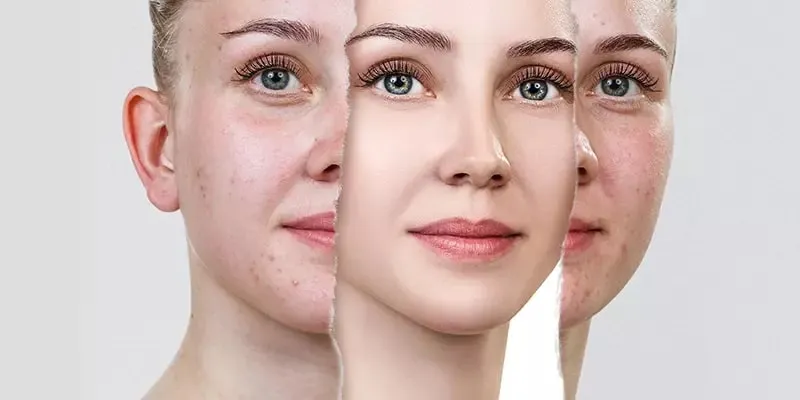Acne does not only occur during puberty; adults can also suffer from it. All told, it affects some 80% of those between 11 and 30. Adults can inherit the embarrassing scars that teenage acne leaves behind, making you feel self-conscious regardless of your age.
But, how do you get rid of acne scars or What to Do to Reduce Acne Scars? Our professional team of aestheticians at Mediterranean Beauty Day Spa offers a variety of facial treatments (mostly organic) to clear your skin and remove visible reminders of your adolescence. Dermaplaning Columbus Ohio is a popular procedure that we are frequently asked about, so we’ve put together this guide to educate you.
What Is Acne? Why does it occur? and Types of Acne
While there are theories that acne is caused by eating oily foods, not washing frequently enough, or wearing the wrong type of makeup, the truth is that these are all contributors to an outbreak, not the primary cause.
The issue is with your skin, which has small openings (pores) that allow oil and sweat to rise to the surface, as well as follicles that produce hairs. Natural oils combined with dirt, bacteria, and dead skin cells easily clog the pores and follicles. This causes them to become inflamed, resulting in a pimple lesion.
Acne pimples are most commonly pus-filled whiteheads and blackheads, which are small and usually heal without scarring. However, if the inflammation persists or if you have a severe case of acne, you may develop scarring. These include:
- Pustules: pus-filled swellings with a red base and white/yellow top
- Papules: painful pink or red bumps
- Nodules: deep, solid, painful lesions
- Cysts: deep, painful pustules that are the most likely to scar
Picking at your lesions will only increase inflammation, pain, and the possibility of scarring, so never pick!
Acne Scars’ Formation and Embracing Levels
Infected papules, pustules, or cysts can rupture the pore or hair follicle. This allows infected material to enter your lower skin layers and destroy healthy tissue. Your body reacts by producing collagen, a protein that gives skin strength and resiliency. If it produces too much collagen, the cells congregate and form a scar. The scar can be raised or indented, lighter or darker than the surrounding skin.
There are three types of acne scars; you can have just one or a combination of two or three:
- Atrophic: collagen doesn’t fill the entire damaged area, causing a shallow indentation in the skin
- Hypertrophic: excess collagen clumps together, forming a raised ridge the same size as the original blemish
- Keloid: excess collagen causes a raised ridge extending beyond the edges of the original blemish
Each type can be treated to varying degrees.
Another sorting type to pose is based on the level of acne embracing:
- mild acne: this causes the whiteheads or blackheads that most of us get at some point
- moderate acne: this can cause red, inflamed pimples (called papules) and red pimples with white centers (called pustules)
- severe acne: this causes painful, pus-filled cysts or lumps (called nodules) under the skin
The most severe acne scarring is caused by nodules, which are more likely to leave permanent scars than other types of acne.
To avoid further severe acne and scarring, it is best to seek treatment for acne as soon as it appears. Consult your doctor or a dermatologist if you have nodules or in other word when your condition is more serious like severe acne.
Get Natural Help for Removing Acne Scars
In order to understand “What to Do to Reduce Acne Scars,” we are going to explain our Dermaplane Facial Service. Dermaplaning is a procedure that exfoliates (removes layers of) your skin, removing dirt, vellus (“peach fuzz”) hair, and anything embedded in the top layer of your skin, such as acne scars.
Some people confuse dermaplaning with dermabrasion, but they are not the same thing. Dermabrasion exfoliates the skin with a high-speed rotating brush. Dermaplaning is performed with a scalpel or a similar tool known as a dermatome. The dermatome is moved back and forth over your skin by the aesthetician to scrape away the top, dead layer and its imperfections.

Dermaplaning is an excellent method for deep exfoliation and acne scar removal without the use of harsh abrasives or peeling agents.
The treatment takes about 30 minutes, there is no downtime, and you can repeat it as needed every 3-4 weeks. While the procedure is effective at removing acne scars in the uppermost layer, if your scars are deeper in the tissue, you should consider one of our other facial treatments. When you come in for your consultation, we can advise you on the best course of action.
If you’re bothered by the appearance of acne scars, it’s time to do something about it. Contact Mediterranean Beauty Center for Aesthetics to set up a skin evaluation and learn about all the facial options we offer. In Mild and most of Moderate acne cases you can count on us for What to Do to Reduce/Remove Acne Scars!
Book online appointment if you are already our client.
First and foremost, before getting a facial service, contact for a free consultation and skin evaluation.
Call us at (614) 940-0886
693 1/2 High Street, Suite A,
Worthington, OH 43085

